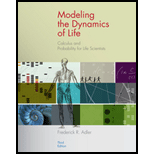
Concept explainers
a.
To find:The population of bacteria after 1, 2, and 3 hours.
a.
Answer to Problem 58E
The population of bacteria after 1, 2, and 3 hours that go to next stage is
Explanation of Solution
Given:
The population of bacteria doubles every hour but that
Formula used:
The next hour bacteria population is
Calculation:
In the beginning the bacteria population is
Since, population of bacteria doubles every hour, and before the next stage culture
The population of bacteria after 1hour
The population of bacteria after 1 hour before reproduction
The population of bacteria after 2 hour
The population of bacteria after 1 hour before reproduction
The population of bacteria after 1 hour
The population of bacteria after 1 hour before reproduction
Conclusion:
The populationof bacteria after 1, 2, and 3 hours that go to next stage is
b.
To write:The discrete- time dynamical system for bacteria population growth.
b.
Answer to Problem 58E
The discrete- time dynamical system for bacteria population growth is
Explanation of Solution
Given:
The population of bacteria doubles every hour but that
Concept used:
The population of bacteria doubles every hour but that
Explanation: (From data in part (a))
Let at any time “ t ” the population of bacteria is
Conclusion:
The discrete- time dynamical system for bacteria population growth is
c.
To compare:The population growth with the problem if individual bacteria are removed after each hour to the population growth with the problem if individual bacteria are removed after 3rd hour.
c.
Answer to Problem 58E
If bacteria are not removed then the population of bacteria after 1, 2, and 3 hours that go to next stage will be
Explanation of Solution
Given:
Given and calculated data in part (a).
Concept used:
Given in part (a).
If the
But if bacteria are not removed then the population of bacteria after 1, 2, and 3 hours that go to next stage will be
Want to see more full solutions like this?
Chapter 1 Solutions
Modeling the Dynamics of Life: Calculus and Probability for Life Scientists
 Linear Algebra: A Modern IntroductionAlgebraISBN:9781285463247Author:David PoolePublisher:Cengage LearningAlgebra & Trigonometry with Analytic GeometryAlgebraISBN:9781133382119Author:SwokowskiPublisher:Cengage
Linear Algebra: A Modern IntroductionAlgebraISBN:9781285463247Author:David PoolePublisher:Cengage LearningAlgebra & Trigonometry with Analytic GeometryAlgebraISBN:9781133382119Author:SwokowskiPublisher:Cengage

